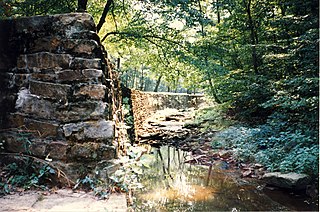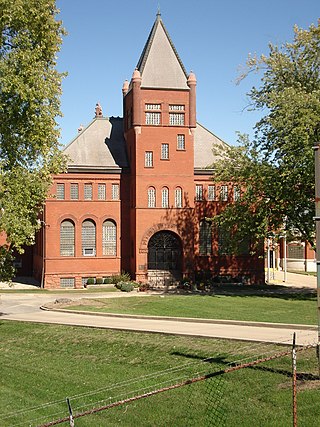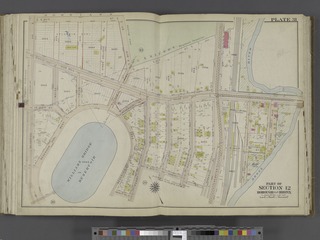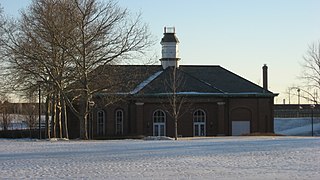
El Morro National Monument is a U.S. national monument in Cibola County, New Mexico, United States. Located on an ancient east–west trail in the western part of the state, the monument preserves the remains of a large prehistoric pueblo atop a great sandstone promontory with a pool of water at its base, which subsequently became a landmark where over the centuries explorers and travelers have left personal inscriptions that survive today.

Old Las Vegas Mormon Fort State Historic Park is a state park of Nevada, containing the Old Mormon Fort, the first structure built by people of European heritage in what would become Las Vegas fifty years later. In present-day Las Vegas, the site is at the southeast corner of Las Vegas Boulevard and Washington Avenue, less than one mile north of the downtown area and Fremont Street. This is the only U.S. state park located in a city that houses the first building ever built in that city. The fort was listed on the National Register of Historic Places on February 1, 1972. The site is memorialized with a tablet erected by the Church of Jesus Christ of Latter-day Saints in 1997, along with Nevada Historical Marker #35, and two markers placed by the Daughters of Utah Pioneers.

Hubbell Trading Post National Historic Site is a historic site on Highway 191, north of Chambers, with an exhibit center in Ganado, Arizona. It is considered a meeting ground of two cultures between the Navajo and the settlers who came to the area to trade.

The Simms Building is historic high-rise office building in downtown Albuquerque, New Mexico. Designed by Flatow and Moore and completed in 1954, it was the city's first large-scale modernist building and is regarded as "Albuquerque’s best example of the International Style". The building was added to the New Mexico State Register of Cultural Properties in 1997 and the National Register of Historic Places in 1998, only 44 years after it was completed.

Giant City State Park is an Illinois state park on 4,000 acres (1,619 ha) in Jackson and Union Counties, Illinois, United States. Illinois acquired more than 1,100 acres (450 ha) in 1927, and dedicated the park as Giant City State Park. A lodge and visitor center welcome state park guests.

Peoria Waterworks is a building complex built in 1890 for the Peoria, Illinois water system.

The Eden Park Station No. 7 is a historic structure located in Eden Park in Cincinnati, Ohio, United States. Constructed in the late nineteenth century as a significant part of the city water supply system, it was used for its original purpose for only a few decades. As a work of Cincinnati's most important architect, it has been named a historic site.

This is a list of the National Register of Historic Places listings in Pine County, Minnesota. It is intended to be a complete list of the properties and districts on the National Register of Historic Places in Pine County, Minnesota, United States. The locations of National Register properties and districts for which the latitude and longitude coordinates are included below, may be seen in an online map.

Williamsbridge Reservoir was a natural lake measuring 13.1 acres (5.3 ha) just south of Van Cortlandt Park in the Bronx, New York. Specifically the body of water was located at 208th Street and Bainbridge Avenue. It was shaped like a saucer and was normally 41 feet (12 m) deep. Its water level dropped approximately 14 feet (4.3 m) in mid-August 1901. On April 3, 1934 Commissioner of Water Supply, Gas and Electricity, Maurice P. Davidson, proposed that it be offered to Robert Moses to be used as a park site. The reservoir had ceased to be used after 1919.

The historical buildings and structures of Zion National Park represent a variety of buildings, interpretive structures, signs and infrastructure associated with the National Park Service's operations in Zion National Park, Utah. Structures vary in size and scale from the Zion Lodge to road culverts and curbs, nearly all of which were designed using native materials and regional construction techniques in an adapted version of the National Park Service Rustic style. A number of the larger structures were designed by Gilbert Stanley Underwood, while many of the smaller structures were designed or coordinated with the National Park Service Branch of Plans and Designs. The bulk of the historic structures date to the 1920s and 1930s. Most of the structures of the 1930s were built using Civilian Conservation Corps labor.

The Silver City Historic District is a historically significant section of downtown Silver City, New Mexico, United States.

The Chillicothe Water and Power Company Pumping Station is a historic building on the northern side of Chillicothe, Ohio, United States. A Gothic Revival structure built in 1881, it was constructed to house the city's waterworks and power plant. Its architecture and its location in Yoctangee Park was chosen specifically in order to beautify the park as well as to have a location near other elements of the city's first waterworks, which were built at the same time as the pumping station.

The Enchanted Mesa Trading Post at 9612 Central Ave. SE. in Albuquerque, New Mexico was built in 1948. It was a work of Margarete Chase and it was a work of a John Hill. It was listed on the New Mexico State Register of Cultural Properties in 1997 and the National Register of Historic Places in 1998.

The Evansville Standpipe is a historic water tower located in Evansville, Wisconsin. The 80-ft tall steel tower was built in 1901 by the Chicago Bridge & Iron Company, as part of the development of the local water supply system, spurred on by a devastating fire in 1896 that destroyed a large section of downtown Evansville. It was added to the National Register of Historic Places in 2008.

The Silver City Woman's Club is a historic women's club located at 411 Silver Heights Boulevard in Silver City, New Mexico. The club was founded in 1909, and it built its meeting house in 1935–36. Richard Tatsch designed the clubhouse in the Pueblo Revival style, which reflected the region's architectural history. The clubhouse provided two spaces for the club's community activities and private meetings; the former included distributing food to needy families and conducting child welfare inspections on behalf of the state, while the latter included self-improvement courses in music and literature. The women's club has continuously held its activities in the building since its construction; it has also provided a space for community meetings and large events.

West Washington Street Pumping Station is a historic pumping station located in Indianapolis, Indiana. It was built in 1870, and is a one-story, rectangular brick building. It was modified to its present form after 1909, and is 2/3 of its original size. It has a slate hipped roof topped by a square central tower and features distinctive brick detailing, and arched openings. The building served as the city's only water pumping station until 1890.

Monte Vista Fire Station is a historic former fire station in the Nob Hill neighborhood of Albuquerque, New Mexico. Built in 1936 using Works Progress Administration funding, it is notable as a well-preserved WPA municipal project and for its significance in the early development of the Nob Hill area. The building served in its original role as a fire station until 1972 and currently houses a restaurant. It is the city's third oldest surviving fire station after the AT&SF Fire Station, built in 1920, and the old station #2 on the corner of High St. and Silver Ave. opened in 1926.

Sewage Pumping Station 27 is a heritage-listed former sewage pumping station situated in Callan Park, Rozelle, Inner West Council, Sydney, New South Wales, Australia. It is also known as SPS 27. The building is located on the southern side of King George Park. The property is owned by Sydney Water. It was added to the New South Wales State Heritage Register on 18 November 1999.

The Carrizozo Woman's Club, at 908 Eleventh St., Carrizozo, New Mexico is a woman's club. Its building was constructed in 1939 and was listed on the National Register of Historic Places in 2003.

The A&P Superintendent's House is a historic house in the Barelas neighborhood of Albuquerque, New Mexico. It was built in 1881 for Frank W. Smith, who used it as his base of operations while supervising construction of the Atlantic and Pacific Railroad from Albuquerque to Needles, California. It is built from red sandstone, believed to have been quarried near Laguna Pueblo, which was the same material used to build the A&P's maintenance facilities on the opposite side of Second Street. Those buildings were replaced by the Santa Fe Railway Shops beginning in 1912, leaving the Superintendent's House as the city's only surviving building associated with the A&P. The house was listed on the New Mexico State Register of Cultural Properties in 1975 and the National Register of Historic Places in 1978.






















